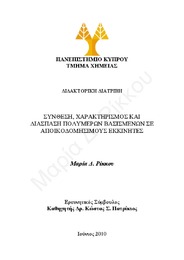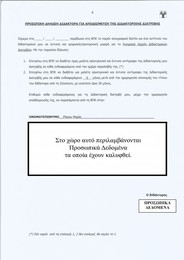| dc.contributor.advisor | Πατρίκιος, Κώστας | el |
| dc.contributor.author | Ρίκκου, Μαρία Δ. | el |
| dc.coverage.spatial | Κύπρος | el |
| dc.coverage.spatial | Cyprus | en |
| dc.creator | Ρίκκου, Μαρία Δ. | el |
| dc.date.accessioned | 2012-09-21T06:29:38Z | |
| dc.date.accessioned | 2017-08-03T10:41:25Z | |
| dc.date.available | 2012-09-21T06:29:38Z | |
| dc.date.available | 2017-08-03T10:41:25Z | |
| dc.date.issued | 2010-07 | |
| dc.date.submitted | 2010-07-29 | |
| dc.identifier.uri | https://gnosis.library.ucy.ac.cy/handle/7/39484 | en |
| dc.description | Περιέχει βιβλιογραφία. | el |
| dc.description | Αριθμός δεδηλωμένων πηγών στη βιβλιογραφία: 103 | el |
| dc.description | Διατριβή (Διδακτορική) -- Πανεπιστήμιο Κύπρου, Σχολή Θετικών και Εφαρμοσμένων Επιστημών, Τμήμα Χημείας, Ιούλιος 2010. | el |
| dc.description | Η βιβλιοθήκη διαθέτει αντίτυπο της διατριβής σε έντυπη μορφή. | el |
| dc.description.abstract | Στα πλαίσια της παρούσας Διδακτορικής Διατριβής πραγματοποιήθηκε η σύνθεση αποικοδομήσιμων πολυμερών με δύο διαφορετικές αρχιτεκτονικές: αυτές των πολυμερικών πλεγμάτων διασυνδεδεμένων στα άκρα, και αυτές των υπερδιακλαδισμένων πολυμερών. Στα πολυμερή αυτά, η αποικοδομήσιμη ομάδα εισήχθηκε μέσω του εκκινητή ή μέσω του inimer, αντίστοιχα. Η σύνθεση των πλεγμάτων επιτεύχθηκε με τρεις διαφορετικές ζωντανές μεθόδους πολυμερισμού: τον πολυμερισμό μεταφοράς ομάδας (GTP), τον πολυμερισμό ριζών με μεταφορά ατόμου (ATRP) και τον πολυμερισμό ριζών μεταφοράς αλυσίδας με αντιστρεπτή προσθήκη-απόσπαση (RAFT). Για την κάθε μέθοδο πολυμερισμού που χρησιμοποιήθηκε για τη σύνθεση των πολυμερικών πλεγμάτων, συντέθηκε και ο κατάλληλος διασπώμενος εκκινητής που φέρει και δύο ομάδες εστερικής ημιακετάλης. Στη συνέχεια, πραγματοποιήθηκαν κινητικές μελέτες υδρόλυσης των πλεγμάτων που έδειξαν σημαντική επίδραση της σύστασης αλλά και της αρχιτεκτονικής τους στην ταχύτητα υδρόλυσής τους. Ακολούθως, τα προϊόντα υδρόλυσης των πλεγμάτων, τα οποία είναι αστεροειδή πολυμερή, χαρακτηρίστηκαν ως προς το απόλυτο μοριακό τους βάρος από το οποίο υπολογίστηκε ο αριθμός βραχιόνων τους και προσδιορίστηκε έτσι, για πρώτη φορά, και ο αριθμός αλυσίδων στους κόμβους διασταύρωσης των πλεγμάτων. Επιπλέον, πέραν από τα πολυμερικά πλέγματα, στα πλαίσια αυτής της Διδακτορικής Διατριβής, πραγματοποιήθηκε και η σύνθεση τριών οικογενειών υπερδιακλαδισμένων πολυμερών. Η σύνθεση των υπερδιακλαδισμένων πολυμερών επιτεύχθηκε με τη μέθοδο ATRP, και πραγματοποιήθηκε με συμπολυμερισμό του εκκινητή-μονομερούς (inimer) με τα μονομερή. Τα υπερδιακλαδισμένα πολυμερή χαρακτηρίστηκαν ως προς τα μέσου-αριθμού μοριακά τους βάρη και ως προς τα απόλυτα μέσου-βάρους μοριακά βάρη με GPC και SLS. Στη συνέχεια, πραγματοποιήθηκε θερμόλυση των υπερδιακλαδισμένων πολυμερών που είχε σαν αποτέλεσμα το σχηματισμό γραμμικών προπομπών. | el |
| dc.description.abstract | The present Doctoral Thesis reports the syntheses of degradable polymers with two different architectures, end-linked polymer (co)networks and hyperbranched polymers, in which the degradable group was introduced through the initiator and the inimer, respectively. The end-linked polymer (co)networks were synthesized using three different living polymerization methods: group transfer polymerization (GTP), atom transfer radical polymerization (ATRP) and reversible addition-fragmentation chain transfer polymerization (RAFT). For each polymerization method used for the preparathion of the (co)neworks, an appropriate degradable bifunctional initiator with two labile hemiacetal ester groups was synthesized. Subsequently, the cleavable dried conetworks were subjected to swelling and degradation in pure water, and the kinetics was followed gravimetrically and by small-angle neutron scattering (SANS). The rate of conetwork hydrolysis depended both on their composition and architecture. The hydrolysis products were characterized in terms of their molecular weight. These hydrolysis products were the expected star polymers and their characterization provided information about the core functionality of the (co)networks synthesized by sequential addition, an unknown structural parameter of the system to date. Furthermore, in this study three families of hyperbranched polymers were synthesized. Hyperbranched polymers were synthesized via ATRP by copolymerization of the inimer with the monomers. Both degradable and non-degradable hyperbranched polymers were characterized in terms of their molecular weight and composition using GPC, SLS and 1H NMR spectroscopy. Subsequently, the cleavable hyperbranched polymers were subjected to thermolysis and produced linear polymers. Thermolysis rates were found to depend on the molecular weights of the hyperbranched polymers. | en |
| dc.format.extent | xiv, 176 σ., [362] σ. με πίνακες : εικ. ; 30 εκ. | el |
| dc.language.iso | gre | en |
| dc.publisher | Πανεπιστήμιο Κύπρου, Σχολή Θετικών και Εφαρμοσμένων Επιστημών / University of Cyprus, Faculty of Pure and Applied Sciences | |
| dc.rights | info:eu-repo/semantics/openAccess | en |
| dc.rights | Open Access | en |
| dc.subject.lcsh | Polymer networks | en |
| dc.subject.lcsh | Polymerization | en |
| dc.subject.lcsh | Polymers | en |
| dc.title | Σύνθεση, χαρακτηρισμός και διάσπαση πολυμερών βασισμένων σε αποικοδομήσιμους εκκινητές | el |
| dc.title.alternative | Synthesis, Characterization And Degradation of Polymers Based on Degradable Initiators | en |
| dc.type | info:eu-repo/semantics/doctoralThesis | en |
| dc.contributor.committeemember | Πατρίκιος, Κώστας | el |
| dc.contributor.committeemember | Λεοντίδης, Επαμεινώνδας | el |
| dc.contributor.committeemember | Νικολαϊδης, Αθανάσιος | el |
| dc.contributor.committeemember | Πιτσικάλης, Μαρίνος | el |
| dc.contributor.committeemember | Πίσσης, Πολύκαρπος | el |
| dc.contributor.committeemember | Patrikios, Costas | en |
| dc.contributor.committeemember | Leontides, Epameinondas | en |
| dc.contributor.committeemember | Nicolaides, Athanasios | en |
| dc.contributor.committeemember | Pitsikalis, Marinos | en |
| dc.contributor.committeemember | Pissis, Polykarpos | en |
| dc.contributor.department | Πανεπιστήμιο Κύπρου, Σχολή Θετικών και Εφαρμοσμένων Επιστημών, Τμήμα Χημείας | el |
| dc.contributor.department | University of Cyprus, Faculty of Pure and Applied Sciences, Department of Chemistry | en |
| dc.subject.uncontrolledterm | ΠΟΛΥΜΕΡΙΚΑ ΠΛΕΓΜΑΤΑ | el |
| dc.subject.uncontrolledterm | ΥΠΕΡΔΙΑΚΛΑΔΙΣΜΕΝΑ ΠΟΛΥΜΕΡΗ | el |
| dc.subject.uncontrolledterm | ΑΠΟΙΚΟΔΟΜΗΣΙΜΟΙ ΕΚΚΙΝΗΤΕΣ | el |
| dc.subject.uncontrolledterm | ΑΜΦΙΦΙΛΙΚΑ ΠΛΕΓΜΑΤΑ | el |
| dc.subject.uncontrolledterm | ΑΠΟΙΚΟΔΟΜΗΣΙΜΑ ΠΟΛΥΜΕΡΗ | el |
| dc.subject.uncontrolledterm | ΠΛΕΓΜΑΤΑ ΔΙΑΣΥΝΔΕΔΕΜΕΝΑ ΣΤΑ ΑΚΡΑ | el |
| dc.subject.uncontrolledterm | ΠΟΛΥΜΕΡΙΣΜΟΣ ΡΙΖΩΝ ΜΕ ΜΕΤΑΦΟΡΑ ΑΤΟΜΟΥ | el |
| dc.subject.uncontrolledterm | ΠΟΛΥΜΕΡΙΣΜΟΣ ΜΕ ΜΕΤΑΦΟΡΑ ΟΜΑΔΑΣ | el |
| dc.subject.uncontrolledterm | POLYMER NETWORKS | en |
| dc.subject.uncontrolledterm | HYPERBRANCHED POLYMERS | en |
| dc.subject.uncontrolledterm | DEGRADABLE INITIATORS | en |
| dc.subject.uncontrolledterm | AMPHIPHILIC NETWORKS | en |
| dc.subject.uncontrolledterm | DEGRADABLE POLYMER | en |
| dc.subject.uncontrolledterm | END-LINKED NETWORKS | en |
| dc.subject.uncontrolledterm | ATOM TRANSFER RADICAL POLYMERIZATION | en |
| dc.subject.uncontrolledterm | GROUP TRANSFER POLYMERIZATION | en |
| dc.identifier.lc | QD281.P6R55 2010 | en |
| dc.author.faculty | Σχολή Θετικών και Εφαρμοσμένων Επιστημών / Faculty of Pure and Applied Sciences | |
| dc.author.department | Τμήμα Χημείας / Department of Chemistry | |
| dc.type.uhtype | Doctoral Thesis | en |
| dc.rights.embargodate | 2011-01-29 | |
| dc.contributor.orcid | Πατρίκιος, Κώστας [0000-0001-8855-0370] | |



